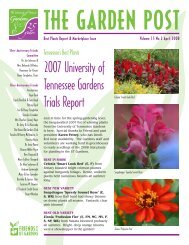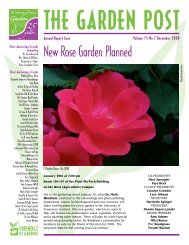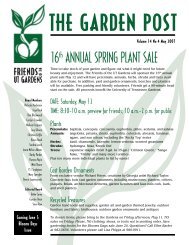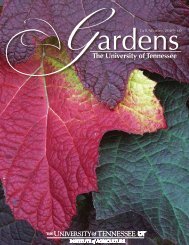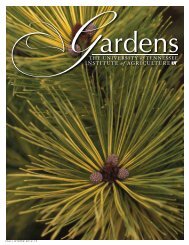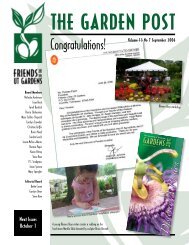October - UT Gardens - The University of Tennessee
October - UT Gardens - The University of Tennessee
October - UT Gardens - The University of Tennessee
You also want an ePaper? Increase the reach of your titles
YUMPU automatically turns print PDFs into web optimized ePapers that Google loves.
Longtime Friend Dr. Alan Solomon, a researcher<br />
at the <strong>UT</strong> Graduate School <strong>of</strong> Medicine, has been<br />
awarded a five-year renewal <strong>of</strong> a grant from the<br />
National Institutes <strong>of</strong> Health’s National Cancer<br />
Institute. Dr. Solomon is pr<strong>of</strong>essor <strong>of</strong> medicine and<br />
director <strong>of</strong> the Human Immunology and Cancer/<br />
Alzheimer’s Disease and Amyloid-Related Disorders<br />
Research Program. He has devoted 42 years to<br />
the study, diagnosis and treatment <strong>of</strong> cancer and<br />
amyloidosis. <strong>The</strong> grant is one <strong>of</strong> the longest active<br />
NIH grants in NIH history and is the longest running<br />
NIH grant in <strong>UT</strong> history. Originally awarded to Dr.<br />
Solomon in 1965, the grant has been renewed<br />
continually for the past 42 years and has provided<br />
more than $12 million to fund Dr. Solomon’s work<br />
at <strong>UT</strong>. Congratulations Dr. Solomon!<br />
A new book collects 132 gardening columns <strong>of</strong><br />
Elizabeth Lawrence. Beautiful at All Seasons:<br />
Southern Gardening and Beyond is edited by Ann<br />
L. Armstrong and Lindie Wilson. Ms. Wilson has been<br />
the owner and steward <strong>of</strong> Lawrence’s former home<br />
and garden in Charlotte, N.C., for 20 years. <strong>The</strong> new<br />
book showcases Lawrence’s vast knowledge, her<br />
intimate, conversational writing style and her lifelong<br />
celebration <strong>of</strong> gardens and gardening. For more<br />
information visit www.elizabethlawrence.org.<br />
In September, 68-year-old self-taught topiary<br />
artist Pearl Fryar visited Knoxville as guest <strong>of</strong><br />
the Knoxville Museum <strong>of</strong> Art and the Knoxville<br />
Botanical Garden. Fryar was discovered in<br />
Bishopville, S.C., by Polly Laffitte, then curator<br />
<strong>of</strong> art for the South Carolina State Museum. Ms.<br />
Laffitte is now associate director <strong>of</strong> development<br />
for the College <strong>of</strong> Arts and Sciences at <strong>UT</strong>. She<br />
also directed photography for the documentary<br />
“A Man Named Pearl,” which showed at Downtown<br />
West in early September for a limited but well<br />
received run.<br />
Virginia Tech will establish a terrace garden at the<br />
Hahn Horticulture Garden in memory <strong>of</strong> Jocelyne<br />
Couture-Nowak, a victim <strong>of</strong> the April 16 shootings<br />
and the wife <strong>of</strong> Jerzy Nowak, head <strong>of</strong> the<br />
Horticulture Department at Virginia Tech. She was<br />
an avid gardener and a French instructor at the<br />
college.<br />
We are always happy to include news about<br />
members and gardening-related events. Please send<br />
contributions to friends<strong>of</strong>theutgardens@utk.edu.<br />
Letters<br />
From Kerrie Wetzel Bradford, a <strong>UT</strong> 1999<br />
alumna from Ornamental Horticulture and<br />
Landscape Design who is now a teacher <strong>of</strong> agriculture<br />
in Kingsport. She recently wrote eTorch,<br />
the online alumni newsletter, along with many<br />
other <strong>UT</strong> alumni to praise their best teachers.<br />
Her choice was Dr. Don Williams:<br />
“It was a real privilege to be a part <strong>of</strong> Dr.<br />
Williams’s class. He was true to his pr<strong>of</strong>ession<br />
and fair in the classroom. He expected us all<br />
to work as equals, even us girls in his landscape<br />
construction class. He not only inspired<br />
me pr<strong>of</strong>essionally, but personally as well,<br />
when he would open his home and family<br />
life to us each semester for a department<br />
social at his home. Because <strong>of</strong> him, I chose to<br />
pursue teaching agriculture as a career, and<br />
I strive to touch at least one person’s life like<br />
he did mine. His passing was a true loss for<br />
<strong>UT</strong>.” It was, indeed.<br />
From new Sponsoring Friend Connie Gonzalez:<br />
“<strong>The</strong> <strong>Gardens</strong> have been transformed since<br />
I visited them a year ago. I did not realize<br />
I could become a Friend <strong>of</strong> the Garden but<br />
from now on my husband and I will be<br />
contributors.”<br />
From <strong>UT</strong> President Emeritus Dr. Joe Johnson<br />
to executive director <strong>The</strong>resa Pepin:<br />
“Pat and I had a wonderful time on Sunday<br />
afternoon, June 24, at the current year’s<br />
Blooms Days Event. You, Mary Spengler,<br />
Mary Collins-Shepard, John Hodges, Susan<br />
Hamilton, and other fine volunteers <strong>of</strong> the<br />
Friends <strong>of</strong> the <strong>Gardens</strong> did a grand job, even<br />
though you had to work around the much<br />
sought after new and impressive entrance.<br />
Pat and I wandered, looked, appreciated<br />
and enjoyed the beauty <strong>of</strong> the <strong>Gardens</strong>. We<br />
shopped and bought two items and had cones<br />
<strong>of</strong> ice cream. Thank you and your associates<br />
for great and important work and leadership.”<br />
Friends’ <strong>Gardens</strong> Reports<br />
<strong>The</strong> Friends email inbox and listserv received<br />
several comments from members about their<br />
experiences in this year <strong>of</strong> the “frozen fries”—the<br />
Easter Sunday freeze and the interminable<br />
drought and heat that followed:<br />
From Peggy Tippens, master gardener and owner<br />
<strong>of</strong> Garden Bouquets & More:<br />
In the last five months, we have had really weird<br />
weather—a zapping freeze in April followed by<br />
extreme summer heat and drought. Leaves now fall<br />
on parched ground weeks before autumn is due to<br />
arrive. Rain is scarce and seems to miss our street<br />
when it does come. We experience patience and<br />
perseverance when dealing with Mother Nature. But<br />
there is good news. Nothing in our yard died. Yes,<br />
the freeze nipped foliage on some roses, hydrangeas<br />
and Japanese maples, but others came through<br />
with no damage at all. Most trees, shrubs and perennials<br />
were fine. We live on a hill with open exposure.<br />
Most <strong>of</strong> our two acres is in full sun. It is hard<br />
to understand why two blue ‘Nikko’ hydrangeas<br />
had to be pruned back but two others produced<br />
beautiful blossoms on schedule. <strong>The</strong> ‘Limelights,’<br />
‘Annabelle’ and ‘Snowflakes’ are a bit late blooming<br />
but snubbed their noses at the freeze. ‘Pee Gee’ and<br />
‘Snow Queen’ appear healthy but blooms scarce.<br />
Our collections <strong>of</strong> hollies, viburnums, nandinas<br />
and magnolias were unaffected by the cold. Only<br />
one ‘Sieboldi’ magnolia and one Viburnum ‘shasta<br />
tomentosa’ were stressed. Both are still fighting to<br />
recover due to brutal temperatures.<br />
I believe two factors were involved in successful<br />
recovery from the stress on plants <strong>of</strong> extreme cold<br />
followed by extreme heat: First, WATER. If healthy<br />
plants were well hydrated before the freeze, they<br />
were quicker to recover. Pr<strong>of</strong>essional experts<br />
immediately advised not to prune back damaged<br />
plants, to wait until the plant was no longer in<br />
shock. Also, water well and continue watering as<br />
needed while plants recovered. That factor worked<br />
for us. With a small garden business, Richard and<br />
I were already doing our scheduled irrigating and<br />
maintenance chores.<br />
<strong>The</strong> second factor is placement or exposure in<br />
the landscape. It is interesting that neither protective<br />
fences, trees nor the house served as barriers<br />
from the freeze. Some unprotected plants were<br />
not affected while some with less exposure got<br />
zapped. Richard thinks the success or failure <strong>of</strong> a<br />
plant is in its genes. Who knows? We are fortunate<br />
that, although blooms were a bit late, everything is<br />
alive and coping. <strong>The</strong> gardens are a joy so we are<br />
counting our blessings.<br />
From Laura Kreuzer, community calendar volunteer<br />
for the Friends:<br />
I live in a condo and garden in large tubs and lots<br />
<strong>of</strong> big pots. I also have several water gardens that<br />
have become very popular with the local bird population.<br />
My regular customers are wrens and a dove<br />
or two. But this summer I had everything from huge<br />
crows to cardinals, robins and lots <strong>of</strong> hummers<br />
taking advantage <strong>of</strong> the water supply. Quite a few<br />
butterflies, too, along with ground squirrels and<br />
regular squirrels.<br />
I keep several big clay saucers filled with water and<br />
those seem to be the most popular for bathing. A<br />
small fountain that drips streams <strong>of</strong> water down<br />
several levels is popular with the hummers. <strong>The</strong>y<br />
hover and drink from the streams. Thanks to<br />
the birds, I have no bugs this year and no slugs,<br />
because the birds usually stick around for a<br />
free meal after getting a drink. I run a full service<br />
bird spa!<br />
From Sandi Burdick, owner <strong>of</strong> a large garden in<br />
South Knoxville and chair <strong>of</strong> the Secret <strong>Gardens</strong><br />
2007:<br />
Every crape myrtle in our yard, whether it is a<br />
giant or one <strong>of</strong> the dwarfs, has bloomed more<br />
pr<strong>of</strong>usely this year than ever. Although they all<br />
suffered some dieback from the Easter Sunday<br />
freeze, the blooms below the dead limbs are<br />
smothered in gorgeous, colorful flowers. I only<br />
recently cut the dead limbs <strong>of</strong>f.<br />
8 9



